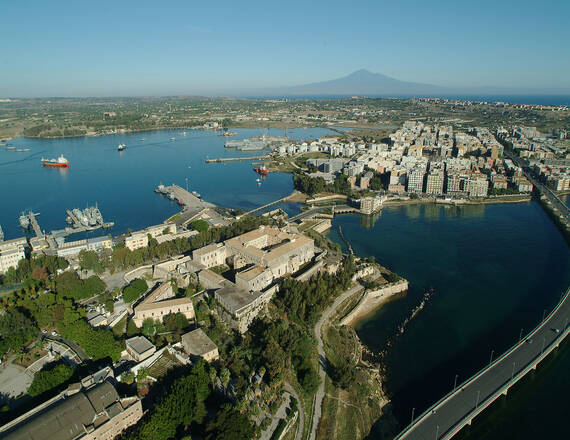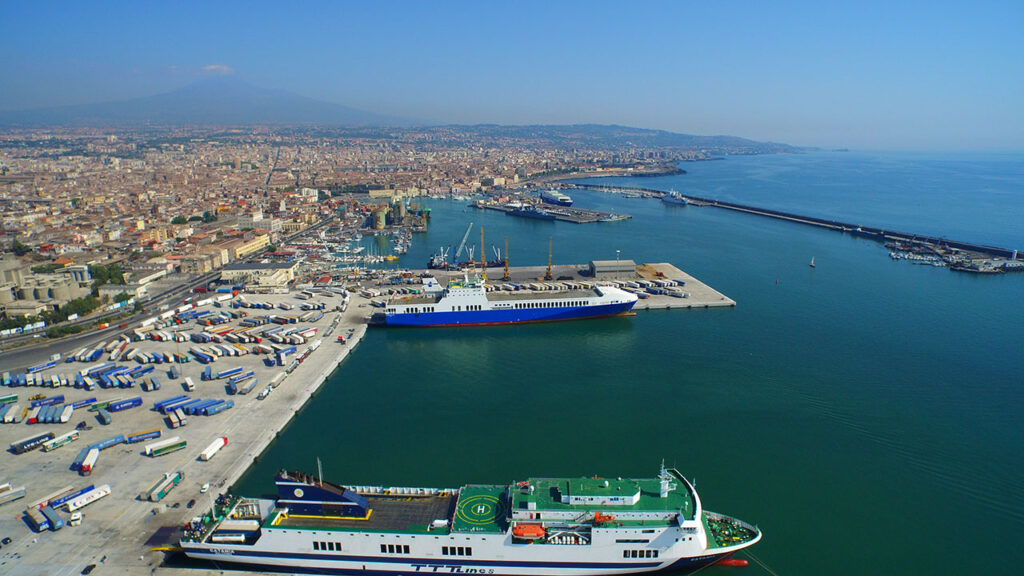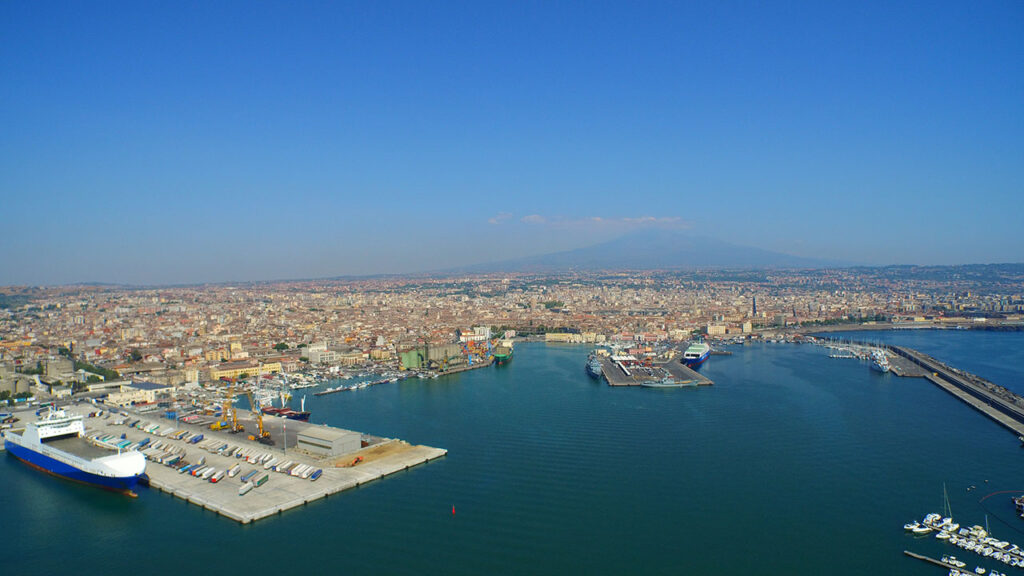╔
Il porto di Catania, tra presente e futuro
Intervista con Francesco DI SARCINA, Presidente dell’Autorità di Sistema Portuale del Mar di Sicilia Orientale
Innanzitutto, vorrei ringraziare l’Ing. Francesco Di Sarcina, Presidente dell’Autorità di Sistema Portuale del Mar di Sicilia Orientale, per la sua gentilezza nel ricevermi e nell’accettare questa intervista per la rivista PORTUS, in occasione del PORTRAIT 47, dedicato alla città di Catania.
Francesco Di Sarcina è un Ingegnere civile ed esperto in pianificazione portuale, in urbanistica e pianificazione waterfront. Dal 2004 ha lavorato nel settore portuale in vari ruoli come dipendente e dirigente di Autorità Portuali prima e di Autorità di Sistema Portuali dopo. È stato Segretario generale dell’Autorità Portuale di Messina; Segretario Generale per due mandati e Commissario Straordinario del Autorità di Sistema Portuale del Mar Ligure Orientale. Attualmente, è Presidente dell’Autorità di Sistema Portuale del Mar di Sicilia Orientale. Ha una profonda conoscenza delle dinamiche di gestione dei porti italiani, comprese le regole dell’economia dei trasporti marittimi, la dinamica dei traffici portuali, la logistica delle merci e l’intermodalità. Una carriera professionale che lo rende un intervistato essenziale e prezioso per i lettori di PORTUS.
Grazie, Presidente, per aver partecipato a questa intervista!
First of all, I would like to thank Engineer Francesco Di Sarcina, President of the Port System Authority of the Eastern Sicily Sea, for his kindness in receiving me and accepting this interview for PORTUS magazine, on the occasion of PORTRAIT 47, dedicated to the city of Catania.
Francesco Di Sarcina is a Civil engineer and expert in port planning, urban and waterfront planning. Since 2004 worked in the port sector in various roles as an employee and manager of Port Authorities first and Port System Authorities later. He was Secretary General of the Port Authority of Messina; Secretary General for two terms and Extraordinary Commissioner of the Port System Authority of the Eastern Ligurian Sea. He is currently President of the Port System Authority of the Eastern Sicily Sea. He has a deep knowledge of the management dynamics of Italian ports, including the rules of maritime transport economics, port traffic dynamics, freight logistics and intermodality. A professional career that makes him an essential and valuable interviewee for PORTUS readers.
Thank you, President, for taking part in this interview!
INTERVISTATRICE | Elena COCUZZA, Ricercatrice di Pianificazione dei Trasporti, DICAR, Università di Catania
INTERVISTATO | Francesco DI SARCINA, Presidente dell’Autorità di Sistema Portuale del Mar di Sicilia Orientale
INTERVIEWER | Elena COCUZZA, Research fellow of Transport Planning, DICAR, University of Catania
INTERVIEWEE | Francesco DI SARCINA, President of the Port System Authority of the Eastern Sicilian Sea
Qual è il ruolo del porto di Catania nello scenario nazionale e internazionale?
Il porto di Catania ha un ruolo principalmente focalizzato sull’importazione ed esportazione di merci, con un volume di esportazione purtroppo molto inferiore rispetto all’importazione, utilizzando prevalentemente la modalità RO RO. Negli ultimi anni, si sono registrati notevoli sviluppi del settore containers. C’è anche una piccola quota di merci alla rinfusa e altri tipi di carichi, che comunque non sono irrilevanti. Sono presenti anche l’attività cantieristica e peschereccia. Inoltre, il porto ha un ruolo commerciale, soprattutto nel settore delle crociere, che al momento è piuttosto limitato e necessita di essere riconsiderato. Infine, il porto ha una funzione turistica che si manifesta anche attraverso la diportistica, amatoriale e sportiva.
Come ha inciso il nuovo ordinamento portuale nazionale, con l’introduzione dei Sistemi Portuali e delle Autorità di Sistema Portuale, nella gestione di uno scalo come quello di Catania?
La risposta è molto chiara. Dal mio punto di vista, i sistemi portuali rappresentano un beneficio, e spiego il perché: i porti italiani sono mediamente piccoli e, da soli, non possono fare molto. Unendosi in un sistema, invece, possono agire come un unico grande porto con più banchine in un’area geografica relativamente ristretta. Il valore positivo rispetto alla gestione singola dei porti si ottiene se, attraverso il sistema, si creano specializzazioni, esaltando le peculiarità di ciascun porto. Se non si fa nulla di diverso rispetto a prima e si lascia ogni porto operare come singolo, non si ottiene alcun beneficio. Quindi, ciò che stiamo facendo è riorganizzare i traffici per esaltare le vocazioni specifiche di ciascun porto, come Augusta, Catania, Pozzallo e, ora, Siracusa.
What is the role of the Port of Catania in the national and international landscape?
The Port of Catania primarily focuses on the import and export of goods, with a significantly higher volume of imports compared to exports, mainly utilizing the RO-RO (roll-on/roll-off) method. In recent years, there have been considerable developments in the container sector. There is also a small share of bulk cargo and other types of loads, which, however, are not insignificant. The port also engages in shipbuilding and fishing activities. Additionally, the port has a commercial role, especially in the cruise sector, which is currently quite limited and needs to be reconsidered. Finally, the port has a tourist function, which is also evident through recreational and sports boating.
How has the new national port system, with the introduction of Port Systems and Port System Authorities, affected the management of a port like Catania?
The answer is very clear. From my perspective, port systems are beneficial, and I’ll explain why: Italian ports are generally small and, alone, they cannot achieve much. By uniting into a system, they can act as a single large port with multiple docks in a relatively confined geographical area. The positive value compared to the individual management of ports is obtained if, through the system, specializations are created, enhancing the unique characteristics of each port. If nothing different is done compared to before and each port is allowed to operate individually, no benefit is obtained. Therefore, what we are doing is reorganizing traffic to highlight the specific roles of each port, such as Augusta, Catania, Pozzallo, and now, Syracuse.

Veduta della Baia di Augusta. (Fonte: Autorità di Sistema Portuale del Mare di Sicilia Orientale).
View of Augusta Bay. (Source: Port System Authority of the Eastern Sicilian Sea).
Qual è la visione strategica per promuovere lo sviluppo sostenibile del porto: porti green -integrazione nave-porto-città?
Dobbiamo distinguere due significati del termine green: uno riguarda l’integrazione tra porto e città, vedendo il porto green in modo romantico; l’altro si riferisce al porto green in termini di emissioni. Partendo da quest’ultimo, ci sono diverse strategie che devono essere attuate immediatamente, indipendentemente dalla nuova pianificazione. Una delle soluzioni è sicuramente intensificare e implementare il Cold Ironing, insieme ad altre iniziative che aiutino gli armatori a spegnere i motori delle navi, riducendo o eliminando le emissioni nei porti. Su questo tema, all’avanguardia e su cui il Governo ha investito molte risorse, le singole Autorità di Sistema Portuale sono state deputate a effettuare vari interventi, anche nell’ambito del PNRR. La nostra Autorità di Sistema sta contribuendo a questi sforzi. Personalmente, ho alcune riserve, perché non vedo un beneficio immediato dalle spese attuali, dato che sia le navi sia le fonti di energia sono quelle di venti o trent’anni fa. Alla fine, trasferiamo la produzione di energia altrove, ma non apportiamo alcun beneficio reale al pianeta. Inoltre, non siamo sicuri che le navi useranno questi nuovi impianti, dato che sono generalmente piuttosto obsolete. Pertanto, a mio avviso, è un tema che deve essere sicuramente affrontato, anche se i risultati si vedranno soltanto nel medio e nel lungo termine, non nel breve termine. Ci sono altre soluzioni che potrebbero essere adottate, come le comunità energetiche o la capacità di autoprodurre l’energia necessaria tramite fonti tradizionali come l’eolico, il fotovoltaico, le maree, e altre ancora. Stiamo valutando attentamente queste iniziative per riuscire ad autoprodurre l’energia necessaria al porto, ovviamente preferendo energia green, per evitare di spostare semplicemente la fonte dell’inquinamento. L’obiettivo è ridurre a zero l’impatto ambientale negativo del porto.
Se, invece, ci riferiamo alla visione green in senso romantico, ovvero come un porto può essere percepito dalla città, allora green significa renderlo più ecologico. Questo implica che il porto di Catania debba avere aree significative, non marginali, dove la città possa godere dei sapori e degli odori del mare e del porto, come è stato fatto recentemente a Palermo. Questo comporta la realizzazione di un’architettura di qualità e una pianificazione attenta, non semplicemente abbattere i cancelli e far entrare le persone come fossero mandrie. Si tratta di dare un motivo per visitare il porto, facilitare l’accesso e offrire un ambiente bello e di qualità. Queste operazioni non riguardano direttamente l’energia verde, anche se possono essere supportate da essa, ma rappresentano una visione “green” più poetica, legata al rapporto tra il porto e la città.
What is the strategic vision for promoting the sustainable development of the port: green ports – integration of ship-port-city?
We need to distinguish between two meanings of the term green: one concerns the integration between the port and the city, viewing the green port in a romantic sense; the other refers to the green port in terms of emissions. Starting with the latter, there are several strategies that need to be implemented immediately, regardless of new planning. One solution is certainly to intensify and implement Cold Ironing, along with other initiatives that help shipowners turn off the ship engines, thereby reducing or eliminating emissions in ports. On this topic, which is at the forefront and on which the Government has invested many resources, individual Port System Authorities have been tasked with carrying out various interventions, also within the framework of the PNRR (National Recovery and Resilience Plan). Our Port System Authority is contributing to these efforts. Personally, I have some reservations because I don’t see an immediate benefit from the current expenses, as both the ships and the energy sources are those of twenty or thirty years ago. In the end, we are merely transferring energy production elsewhere, but we are not providing any real benefit to the planet. Moreover, we are not sure that ships will use these new systems, as they are generally quite obsolete. Therefore, in my opinion, this is an issue that certainly needs to be addressed, although the results will only be seen in the medium and long term, not in the short term. There are other solutions that could be adopted, such as energy communities or the ability to self-produce the necessary energy through traditional sources like wind, solar, tidal, and others. We are carefully evaluating these initiatives to be able to self-produce the energy required by the port, obviously preferring green energy, to avoid simply shifting the source of pollution. The goal is to reduce the negative environmental impact of the port to zero.
If, on the other hand, we refer to the green vision in a romantic sense, that is, how a port can be perceived by the city, then green means making it more ecological. This implies that the Port of Catania should have significant, not marginal, areas where the city can enjoy the flavors and smells of the sea and the port, as has been recently done in Palermo. This involves creating quality architecture and careful planning, not just tearing down gates and letting people in as if they were herds. It’s about giving a reason to visit the port, facilitating access, and offering a beautiful and quality environment. These operations are not directly related to green energy, even though they can be supported by it, but they represent a more poetic “green” vision, related to the relationship between the port and the city.

La darsena commerciale a servizio del traffico RO-RO del Porto di Catania. (Fonte: Autorità di Sistema Portuale del Mare di Sicilia Orientale).
The commercial dock serving the RO-RO traffic in the Port of Catania. (Source: Port System Authority of the Eastern Sicilian Sea).
Qual è l’approccio strategico per favorire lo sviluppo sostenibile del porto, tenendo conto degli strumenti di pianificazione portuale?
Naturalmente, la visione strategica deve essere tradotta in un piano di pianificazione portuale, poiché è lo strumento principale a nostra disposizione. Questo piano deve essere in grado di interpretare le esigenze moderne. In passato, i porti erano semplicemente luoghi in cui le navi attraccavano e scaricavano la merce. Oggi, è essenziale che i porti commerciali si integrino con l’ambiente urbano, pertanto la pianificazione deve assicurare che lo sviluppo urbano e turistico non pregiudichi l’attività commerciale. Il problema principale riguarda le interferenze nelle aree di integrazione porto-città (non nelle aree prettamente operative): ad esempio, le recinzioni devono essere sostituite da spazi aperti dove le persone possano accedere e trovare qualità, intrattenimento, locali, ristoranti e bar. Un altro aspetto importante è evitare che i porti diventino delle barriere per determinati quartieri, promuovendo il miglioramento di tali aspetti. Infine, un altro aspetto fondamentale riguarda le connessioni stradali: se i veicoli privati o adibiti al trasporto pubblico devono condividere la stessa infrastruttura viaria utilizzata dai veicoli adibiti al trasporto di merci in entrata e uscita dal porto, inevitabilmente potrebbero esserci, soprattutto in alcune fasce orarie, delle sovrapposizioni di flussi che possono generare dei conflitti importanti. La soluzione in questi casi è spesso quella di creare strade separate, separando i flussi di traffico in modo che chi entra o esce dal porto segua un percorso completamente diverso da quello dei residenti e dei cittadini, e questi sono gli aspetti su cui ci stiamo concentrando al momento.
What is the strategic approach to promote the sustainable development of the port, considering port planning tools?
Naturally, the strategic vision must be translated into a port planning plan, as it is the main tool at our disposal. This plan must be able to interpret modern needs. In the past, ports were simply places where ships docked and unloaded goods. Today, it is essential that commercial ports integrate with the urban environment; therefore, planning must ensure that urban and tourist development does not jeopardize commercial activities. The main problem concerns the interferences in the port-city integration areas (not in the purely operational areas): for example, fences must be replaced with open spaces where people can access and find quality, entertainment, venues, restaurants, and bars. Another important aspect is to avoid ports becoming barriers for certain neighborhoods, promoting the improvement of these aspects. Finally, another fundamental aspect concerns road connections: if private or public transport vehicles have to share the same road infrastructure used by vehicles for transporting goods in and out of the port, there could inevitably be, especially during certain hours, overlaps of flows that can create significant conflicts. The solution in these cases is often to create separate roads, separating traffic flows so that those entering or leaving the port follow a completely different path from that of residents and citizens, and these are the aspects we are focusing on at the moment.

Le strategie adottate nella nuova pianificazione puntano a risolvere le interferenze tra la città e il porto di Catania, integrando aree portuali e ambiti urbani, attività commerciali e turistiche. (Fonte: Autorità di Sistema Portuale del Mare di Sicilia Orientale).
The strategies adopted in the new planning aim to resolve interference between the city and the port of Catania, integrating port areas and urban environments, commercial and tourist activities. (Source: Port System Authority of the Eastern Sicilian Sea).
Qual è l’impegno del porto nel promuovere lo sviluppo della città di Catania?
L’obiettivo è quello di favorire una comunicazione reciproca e una comprensione delle necessità tra la città e il porto. Vogliamo creare un’area che non sia più considerata esclusivamente portuale, che sia abbastanza ampia da consentire ai cittadini di sentirsi coinvolti e meno sovrastati dalla presenza predominante delle attività commerciali del porto. Spesso i cittadini non comprendono l’importanza di queste attività portuali perché non si rendono conto che i beni di consumo che utilizzano quotidianamente, come abiti, cellulari, orologi e altro, provengono dalle navi che hanno fatto scalo in quel porto. L’idea sarebbe quella di provare a immaginare come sarebbe la vita senza il porto e le sue attività commerciali, per far comprendere meglio la loro importanza.
What is the port’s commitment to promoting the development of the city of Catania?
The goal is to foster mutual communication and understanding of the needs between the city and the port. We want to create an area that is no longer considered exclusively port-related, broad enough to allow citizens to feel involved and less overwhelmed by the predominant presence of commercial port activities. Often, citizens do not understand the importance of these port activities because they do not realize that the consumer goods they use daily, such as clothes, cell phones, watches, and more, come from ships that have docked at that port. The idea would be to try to imagine what life would be like without the port and its commercial activities, to better understand their importance.
IMMAGINE INIZIALE | Veduta del porto e della città di Catania con il vulcano Etna sullo sfondo. (Fonte: Autorità di Sistema Portuale del Mare di Sicilia Orientale).
HEAD IMAGE | View of the port and city of Catania with the Etna volcano in the background. (Source: Port System Authority of the Eastern Sicilian Sea).